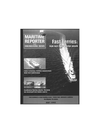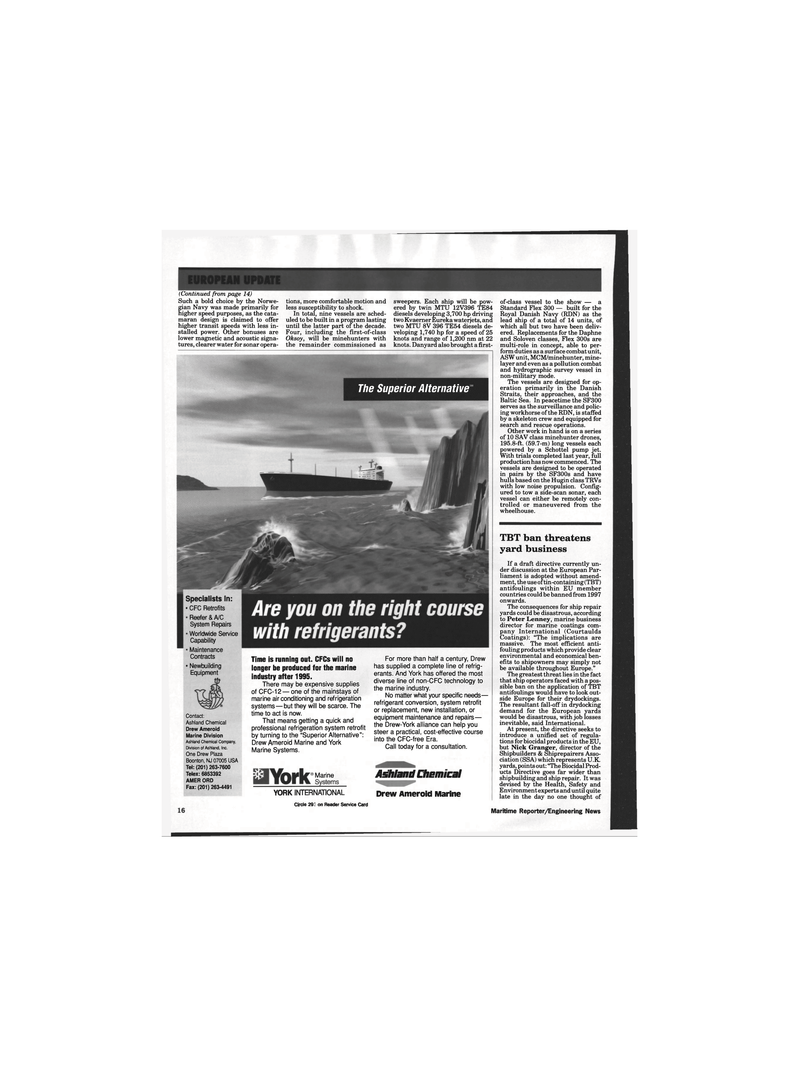
Page 14: of Maritime Reporter Magazine (May 1995)
Read this page in Pdf, Flash or Html5 edition of May 1995 Maritime Reporter Magazine
The Superior Alternative
Contact:
Ashland Chemical
Drew Ameroid
Marine Division
Ashland Chemical Company,
Division of Ashland, Inc.
One Drew Plaza
Boonton, NJ 07005 USA
Tel: (201) 263-7600
Telex: 6853392
AMER ORD
Fax: (201) 263-4491
Specialists In: • CFC Retrofits
Reefer & A/C
System Repairs
Worldwide Service
Capability
Maintenance
Contracts • Newbuilding
Equipment of-class vessel to the show — a
Standard Flex 300 — built for the
Royal Danish Navy (RDN) as the lead ship of a total of 14 units, of which all but two have been deliv- ered. Replacements for the Daphne and Soloven classes, Flex 300s are multi-role in concept, able to per- form duties as a surface combat unit,
ASW unit, MCM/minehunter, mine- layer and even as a pollution combat and hydrographic survey vessel in non-military mode.
The vessels are designed for op- eration primarily in the Danish
Straits, their approaches, and the
Baltic Sea. In peacetime the SF300 serves as the surveillance and polic- ing workhorse of the RDN, is staffed by a skeleton crew and equipped for search and rescue operations.
Other work in hand is on a series of 10 SAV class minehunter drones, 195.8-ft. (59.7-m) long vessels each powered by a Schottel pump jet.
With trials completed last year, full production has now commenced. The vessels are designed to be operated in pairs by the SF300s and have hulls based on the Hugin class TRVs with low noise propulsion. Config- ured to tow a side-scan sonar, each vessel can either be remotely con- trolled or maneuvered from the wheelhouse.
TBT ban threatens yard business (Continued from page 14)
Such a bold choice by the Norwe- gian Navy was made primarily for higher speed purposes, as the cata- maran design is claimed to offer higher transit speeds with less in- stalled power. Other bonuses are lower magnetic and acoustic signa- tures, clearer water for sonar opera- tions, more comfortable motion and less susceptibility to shock.
In total, nine vessels are sched- uled to be built in a program lasting until the latter part of the decade.
Four, including the first-of-class
Oksoy, will be minehunters with the remainder commissioned as sweepers. Each ship will be pow- ered by twin MTU 12V396 TE84 diesels developing 3,700 hp driving two Kvaerner Eureka waterjets, and two MTU 8V 396 TE54 diesels de- veloping 1,740 hp for a speed of 25 knots and range of 1,200 nm at 22 knots. Danyard also brought a first-
If a draft directive currently un- der discussion at the European Par- liament is adopted without amend- ment, the use of tin-containing (TBT) antifoulings within EU member countries could be banned from 1997 onwards.
The consequences for ship repair yards could be disastrous, according to Peter Lenney, marine business director for marine coatings com- pany International (Courtaulds
Coatings): "The implications are massive. The most efficient anti- fouling products which provide clear environmental and economical ben- efits to shipowners may simply not be available throughout Europe."
The greatest threat lies in the fact that ship operators faced with a pos- sible ban on the application of TBT antifoulings would have to look out- side Europe for their drydockings.
The resultant fall-off in drydocking demand for the European yards would be disastrous, with job losses inevitable, said International.
At present, the directive seeks to introduce a unified set of regula- tions for biocidal products in the EU, but Nick Granger, director of the
Shipbuilders & Shiprepairers Asso- ciation (SSA) which represents U.K. yards, points out: "The Biocidal Prod- ucts Directive goes far wider than shipbuilding and ship repair. It was devised by the Health, Safety and
Environment experts and until quite late in the day no one thought of 16 Maritime Reporter/Engineering News
Circle 209 on Reader Service Card
Time is running out. CFCs will no longer be produced for the marine industry after 1995.
There may be expensive supplies of CFC-12 — one of the mainstays of marine air conditioning and refrigeration systems —but they will be scarce. The time to act is now.
That means getting a quick and professional refrigeration system retrofit by turning to the "Superior Alternative":
Drew Ameroid Marine and York
Marine Systems.
For more than half a century, Drew has supplied a complete line of refrig- erants. And York has offered the most diverse line of non-CFC technology to the marine industry.
No matter what your specific needs— refrigerant conversion, system retrofit or replacement, new installation, or equipment maintenance and repairs— the Drew-York alliance can help you steer a practical, cost-effective course into the CFC-free Era.
Call today for a consultation.
Marine Ashland ChEIHICal
YORK INTERNATIONAL Drew Ameroid Marine

 13
13

 15
15
